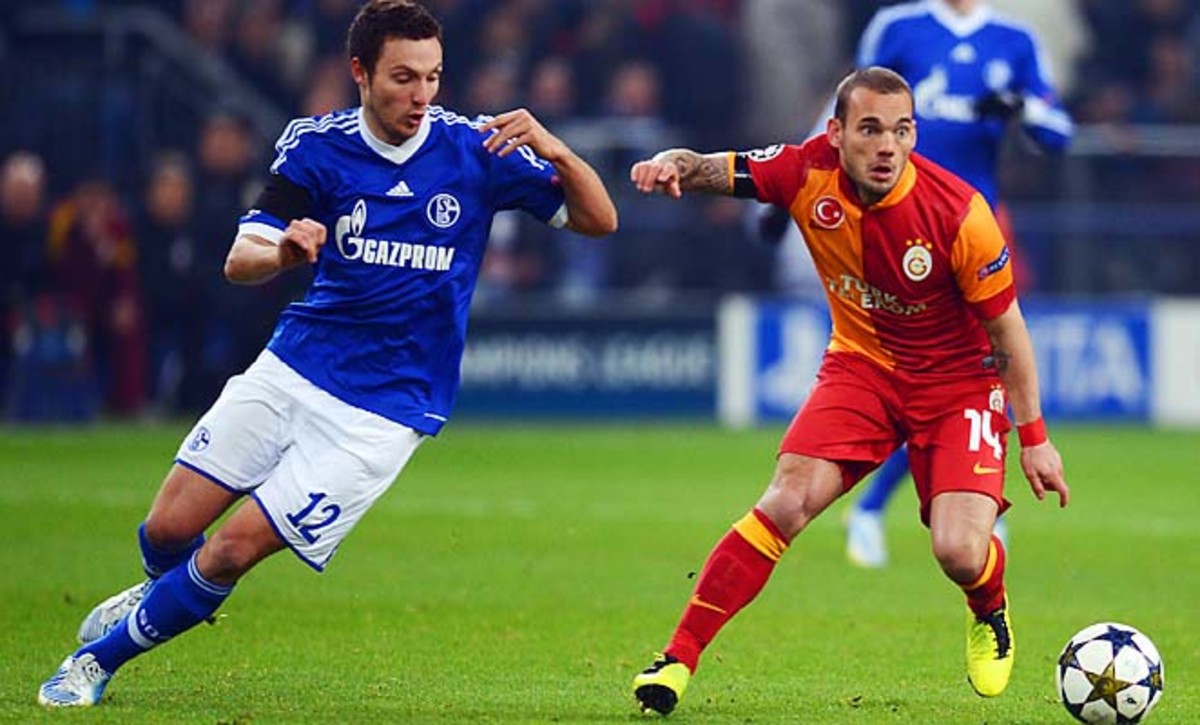
Sneijder's decline a product of his choosing

Thousands of Turkish fans welcomed Wesley Sneijder (right) when he signed in January.
Lars Baron/Getty Images
Every now and again, there comes a player who seems to have been overtaken by the evolution of the game. Michael Owen was one, his style of hanging on the shoulder of the last defender and waiting to be fed, either by a target man or a support striker, left outmoded by the widespread switch to lone-striker systems. Wesley Sneijder is another -- and what's bizarre about his decline is that his step into obsolescence seems to be voluntary.
In a 3-0 loss to Real Madrid on Wednesday, he was used centrally, in a 4-3-1-2. His heat map on the UEFA website is revealing; he played almost entirely in the Real Madrid half, in the central third of the pitch, with a slight left skew. It's the shape of a classic No. 10, of a languorous creator, strolling around, sliding through-balls to forwards. Perhaps somebody playing against Andrea Pirlo could track assiduously and produce a shape like that, but not somebody playing against the more dynamic style of Xabi Alonso and Sami Khedira. Alonso was excellent, dictating play from the back of midfield, but then football is an easier game when there's nobody harassing you.
Not surprisingly, Sneijder was withdrawn at halftime, with defender Gokhan Zan replacing him. Perhaps -- if you're minded to be generous -- that did cost Galatasaray some attacking guile, but it also made it far more solid. By then, though, Galatasaray was 2-0 down and the tie was effectively over; Gonzalo Higuain's goal merely confirmed that. Sneijder did miss Saturday's game against Buyuksehir with a groin injury, which perhaps offers some excuse for his ineffectiveness, but this is a perennial issue.
Yet a few years ago, Sneijder wasn't that sort of player. He seemed, rather, very much of the modern breed; a creative midfielder who actually played like a midfielder rather than as a Juan Riquelme manqué -- think of his energetic performances for Inter Milan as it won the Champions League. The change seemed a sudden one, after the 2010 World Cup in which he scored five goals, three of them deflected, as though those strikes had somehow persuaded him he was a flaneur.
LYTTLETON: Ozil, Real Madrid dominate Galatasaray
Jose Mourinho, it's safe to assume, would not have tolerated a player who suddenly reinvented himself as an old-school playmaker. He, though, had left the club, joining Real Madrid and being replaced by Rafa Benitez. It's not that Benitez is a coach to tolerate players who don't track -- something Eden Hazard has learned this season -- but the Spaniard never had the position of power to do anything about it. The result is that Sneijder has turned himself into an anachronism.
That was painfully apparent in the Champions League quarterfinal in 2011, when Inter was embarrassed 5-2 in the San Siro by Schalke 04. Against a narrow formation, Schalke's fullbacks, Atsuto Uchida and Hans Sarpei, ran riot, while Sneijder stood in his No. 10 position, watching the carnage unfold. Perhaps he'd been instructed not to vacate the central area, but even if that were the case, the fact that Inter's whole formation was built around him made him indirectly responsible.
When Gian Piero Gasperini was appointed Inter coach in 2011 and tried to impose his hard-pressing 3-4-3 with a high defensive line, it was Sneijder who didn't fit, Sneijder whose confused face became the emblem of the campaign that saw the coach removed after just five league games.
The whole issue over his contract was appallingly handled by Inter, of course, and it's not his fault if the club suddenly decided it was unable to afford the terms it had agreed on, but the episode was telling. Not so long ago, the thought of upsetting Sneijder itself would have been taboo; when top clubs really want players, they find a way to afford them -- as Manchester United did when Wayne Rooney submitted his transfer request. Essentially Inter, in financial difficulties, decided Sneijder was a luxury it could do without -- and that's why he moved to Turkey.
It's easy to see why Galatasaray was seduced. By recruiting him and Didier Drogba, it added two Champions League winners to its squad, two players who have been among the most marketable players in the world. Sneijder is still only 28. He should be at the peak of his powers yet it is Drogba, 35, who looks by far the better acquisition. His stamina may be waning, but he is still capable of outmuscling defenders. He still battles for every ball.
Sneijder, meanwhile, has become a problem. Where can he best be used? Do his creative abilities outweigh the deficiencies he creates in the team? Again a coach has found himself changing system to suit him. Twice in the league Sneijder has been used as the central creator in a 4-2-3-1, three times on the left of a 4-4-2 and, in his most recent two games, as the one in a 4-3-1-2. In the last round of the Champions League, against Schalke, he played on the left of a 4-4-2 in the first leg and behind the front two in a 4-3-1-2 in the second. In none of the three games has he made it to the end of the game.
With Owen, there could at least by a sympathy alongside the frustration: he was simply doing what coach after coach had told him to do only to find it was no longer relevant. This, though, is a path Sneijder seems to have chosen. He may find the retro road an increasingly lonely one.




